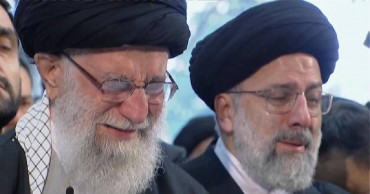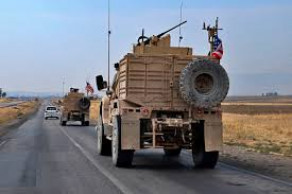American troops
US says airstrikes in Syria intended to send message to Iran
U.S. military airstrikes in eastern Syria were a message to Iran and Tehran-backed militias that targeted American troops this month and several other times over the past year, the Pentagon said Wednesday.
Colin Kahl, the undersecretary of defense for policy, told reporters that the U.S. airstrikes overnight on facilities used by militias backed by Iran’s paramilitary Revolutionary Guard demonstrated that “the United States will not hesitate to defend itself against Iranian and Iran-backed aggression when it occurs.”
He said the U.S. decision to launch the strikes was based on both the nature of the militia attacks on Aug. 15 at the al-Tanf Garrison, where U.S. troops are based in the south, and the fact that, based on recovered drone parts, “we believe we have Iran dead to rights on attribution.”
Hours after the U.S. strikes, two U.S. military locations in northeastern Syria near large oil and gas fields were hit with rocket fire. According to U.S. Central Command, the rockets hit near Green Village and the Conoco gas field in Deir el-Zour. One U.S. service member was treated for a minor injury and has been returned to duty, and two others were under evaluation for minor injuries. CENTCOM said U.S. forces responded by destroying three vehicles and equipment used to launch some of the rockets, killing “two or three suspected Iran-backed militants.”
The opposition war monitor the Syrian Observatory for Human Rights and Deir Ezzor 24 said the U.S. airstrikes targeted the Ayash Camp run by the Fatimiyoun group made up of Shiite fighters from Afghanistan. The war monitor reported that at least six Syrian and foreign militants were killed in the airstrikes, while Deir Ezzor 24 reported 10 deaths.
Deir el-Zour is a strategic province that borders Iraq and contains oil fields. Iran-backed militia groups and Syrian forces control the area and have often been the target of Israeli war planes in previous strikes.
In Iran, Foreign Ministry spokesman Nasser Kanaani issued a statement condemning the American strike “against the people and infrastructure of Syria.” He denied Iran had any link to those targeted.
Read: US airstrikes target militia-controlled areas in east Syria
Iran routinely denies arming militia groups that target U.S. forces in the region, despite weaponry linking back to them.
Kahl said the U.S. strikes underscore that while the U.S. continues to pursue negotiations with Iran to resume its compliance with the 2015 nuclear deal, those talks are not connected at all to America's willingness to take against when attacked.
“The threats that they engage in against our people in the region or elsewhere, are not linked to wherever we end up on the nuclear deal,” said Kahl. “It actually has nothing to do with our willingness and resolve to defend ourselves. And I think the strike last night was a pretty clear communication to the Iranians that these things are are all on different tracks.”
CENTCOM said the U.S. strikes “took proportionate, deliberate action intended to limit the risk of escalation and minimize the risk of casualties.” It did not identify the targets or offer any casualty figures from the strikes, which the military said came at the orders of President Joe Biden.
“Today’s strikes were necessary to protect and defend U.S. personnel,” Central Command spokesman Col. Joe Buccino said in a statement.
Kahl said the militia's coordinated attack on two U.S. facilities at al-Tanf at the same time this month fueled concerns that “Iran intends to do more of this and we wanted to disabuse them of any sense that that was a good idea.”
He said the U.S. initially identified 11 bunker targets at the site and ended up striking nine because there was evidence there may be people near two of the locations and the goal was not to cause casualties.
The U.S. Treasury said the Fatimiyoun group has fought numerous battles in Syria, and is led by Iran’s elite Quds Force of the Revolutionary Guard.
“The Ayash warehouse is a very important one for Iran’s militias,” Deir Ezzor 24 CEO Omar Abu Layla told The Associated Press. “We expect that Iran will respond, either in al-Tanf or possibly in Iraq.”
In the Aug. 15 attack, drones allegedly launched by Iranian-backed militias targeted the al-Tanf Garrison used by American forces. Central Command described the assault as causing “zero casualties and no damage” at the time.
There was no immediate acknowledgment by Syria’s state-run media of the strikes hitting Deir el-Zour.
U.S. forces entered Syria in 2015, backing allied forces in their fight against the Islamic State group.
3 years ago
US Air Force targeted in 'propaganda attack' in Kuwait
The U.S. Air Force said Saturday it was the subject of a “propaganda attack” by a previously unheard-of Iraqi militant group that falsely claimed it had launched a drone attack targeting American troops at an air base in Kuwait.
The statement by the Air Force's 386th Air Expeditionary Wing came hours after the group calling itself Al-Waretheen, or “The Inheritors," put out an online statement claiming that on Aug. 12, it targeted Kuwait's Ali Al Salem Air Base. The statement included a video showing a drone being launched from a stand, but offered no evidence of an attack or any damage done at the base.
The statement claimed the alleged attack aimed to avenge the U.S. drone strike that killed a prominent Iranian Revolution Guard Gen. Qassem Soleimani in Baghdad in January 2020.
Read: Ex-premier’s graft case a test of justice in oil-rich Kuwait
The air base is located a few dozen kilometers (miles) from the Iraqi border.
“The misinformation falsely stated an Iranian militia group used (drones) to carry out an attack on base,” the Air Force statement to The Associated Press said. “No such attack occurred.”
The statement suggests the U.S. believes that Al-Waretheen is likely an Iranian group, though it described itself as Iraqi.
The Air Force added that the online claim “only aims to deceive their audience in believing a lie" and that the Air Force and Kuwait “continue to project air power throughout the region without disruption.”
Kuwait, a small, oil-rich nation bordering Iraq and Saudi Arabia also near Iran, is considered a major non-NATO ally of the United States. Kuwait and the U.S. have had a close military partnership since America launched the 1991 Gulf War to expel Iraqi troops after Iraqi dictator Saddam Hussein invaded the country.
Some 13,500 American troops are stationed in Kuwait, which also hosts U.S. Army Central’s forward headquarters. Those forces have supported the U.S. invasion of Iraq in 2003 and later operations against the Islamic State group.
Kuwait did not immediately acknowledge the claimed attack. Its Information Ministry did not immediately respond to a request for comment Saturday night.
Kuwait’s Al-Qabas newspaper, quoting anonymous “responsible” sources, called the claims about an attack “completely untrue.”
Satellite photos from Planet Labs PBC analyzed by the AP since Aug. 12 show no apparent damage at the base.
A series of militant groups that analysts believe have ties back to Iran have claimed attacks they say targeted U.S. troops in Iraq over recent years. However, those roadside bombings targeted Iraqi contractors supplying American forces in the country.
The claim also comes as what have been described as the final round of negotiations continue between Iran and the U.S. over Tehran's tattered nuclear deal with world powers.
3 years ago
Refugee admissions hit record low, despite Biden's reversal
Refugee admissions to the United States fell to a record low during the 2021 budget year, despite President Joe Biden's pledge to reverse the sharp cuts made by the Trump administration, according to figures obtained by The Associated Press.
A total of 11,445 refugees were allowed into the United States during the budget year that ended on Thursday, according to a person with access to the information who spoke on condition of anonymity because they were not authorized to release the figure.
That number does not include the tens of thousands of Afghans brought to the United States as American troops withdrew from Afghanistan, ending the 20-year war there. Many of those Afghans were allowed into the country under a different legal status known as humanitarian parole, which is why they are not included in the refugee tally.
Read: Libya’s migrant roundup reaches 4,000 amid major crackdown
Still the number highlights Biden's challenges in reversing the restrictive refugee policies set by former President Donald Trump's administration, which targeted the program as part of a broader campaign to slash both legal and illegal immigration to the United States.
The U.S. president determines the cap on refugee admissions each budget year, which runs from Oct. 1 to Sept. 30. Biden didn't take office until almost four months after the last fiscal year began.
The State Department did not immediately respond to a request for comment about the number.
The 11,445 refugee admissions total falls far below the nation’s cap of 62,500 for the 2021 budget year that Biden set in May. It's also below the record-low ceiling of 15,000 that Trump had initially set for the year.
Biden initially indicated he would not override the 15,000-person cap, saying in an emergency determination that it “remains justified by humanitarian concerns and is otherwise in the national interest."
But that brought sharp rebuke from Democratic allies who criticized him for not taking the symbolic step of authorizing more refugees this year. The White House quickly reversed course and raised the cap, though Biden said at the time that he did not expect the U.S. would meet the new 62,500 ceiling with only four months left in the 2021 budget year, given the ongoing restrictions put in place due to the coronavirus pandemic and work the administration says is needed to rebuild the program.
Refugee advocates said the record-low number reflects the damage done by the Trump administration to the program. Before the 2021 budget year, the lowest number of refugees allowed in was during the 2020 budget year when the number hit 11,814.
The historical yearly average was 95,000 under previous Republican and Democratic administrations.
The Biden administration has expanded the narrow eligibility criteria put in place by his predecessor that had kept out most refugees, among other steps. But critics say it's not enough and that the Biden administration has moved too slowly.
It remains to be seen whether refugee admissions will reach anywhere near the 125,000 cap that Biden has set for the current budget year, which started Friday.
Read:Many migrants staying in US even as expulsion flights rise
Krish O’Mara Vignarajah, president of the Lutheran Immigration and Refugee Service, one of nine U.S. agencies working to resettle refugees, said efforts need to be accelerated to add personnel overseas, do more remote interviews and relieve the enormous backlog of refugee applications.
She said that while the program was gutted by the Trump administration, it is now Biden's responsibility to revive it.
“If we are to reach President Biden’s goal of welcoming 125,000 refugees, the administration must be aggressive and innovative in ramping up processing," she said in a statement.
Mark Hetfield of HIAS, another resettlement agency, agreed that Biden “should have done better."
“What this record low number really shows ... is that the administration needs to remove the red tape and other obstacles that hinder the resettlement program from effectively responding to emergencies like Afghanistan," he said.
Biden, who co-sponsored legislation creating the refugee program in 1980, has said reopening the door to refugees is “how we will restore the soul of our nation.”
4 years ago
US to leave troops in Afghanistan beyond May, 9/11 new goal
President Joe Biden has decided to leave American troops in Afghanistan beyond the May 1 deadline negotiated with the Taliban by the Trump administration, and has set the 20th anniversary of the Sept. 11 attacks as the new goal, U.S. officials said Tuesday.
Biden has been hinting for weeks that he was going to let the deadline lapse, and as the days went by it became clear that an orderly withdrawal of the remaining 2,500 troops would be difficult and was unlikely. U.S. officials provided details on Biden’s decision on condition of anonymity, speaking ahead of the announcement. It was first reported by The Washington Post.
His decision risks retaliation by the Taliban on U.S. and Afghan forces, possibly escalating the 20-year war. And it will reignite political division over America’s involvement in what many have called the endless war.
Also read: US wasted billions on cars, buildings in Afghanistan
Setting the 9/11 date, however, underscores the reason that American troops were in Afghanistan to begin with — to prevent extremist groups from establishing a foothold in the country again that could be used to launch attacks against the U.S.
In a February 2020 agreement with the administration of President Donald Trump, the Taliban agreed to halt attacks and hold peace talks with the Afghan government, in exchange for a U.S. commitment to a complete withdrawal by May 2021.
Over the past year, U.S. military commanders and defense officials have said that attacks on U.S. troops have largely paused, but they say the Taliban have increased attacks on the Afghans. Commanders have argued that the Taliban have failed to meet the conditions of the peace agreement by continuing attacks on the Afghans and failing to totally cut ties with al-Qaida and other extremist groups.
Also read: US to cut troop levels to 2,500 in Iraq, Afghanistan
When Biden entered the White House in January, he was keenly aware of the looming deadline and had time to meet it if he had chosen to do so. He launched a review of the February 2020 agreement shortly after taking office, and has been consulting at length with his defense and military advisers as well as allies.
In recent weeks, it became increasingly clear that he was leaning toward defying the deadline.
“It’s going to be hard to meet the May 1 deadline,” Biden said in late March. “Just in terms of tactical reasons, it’s hard to get those troops out.” Tellingly, he added, “And if we leave, we’re going to do so in a safe and orderly way.”
4 years ago
Weeping, Iran supreme leader prays over general slain by US
Weeping amid wails from a crowd of hundreds of thousands of mourners, Iran's supreme leader on Monday prayed over the remains of a top Iranian general killed in a U.S. airstrike in Baghdad, an attack that's drastically raised tensions between Tehran and Washington.
5 years ago
Iraq: American troops leaving Syria cannot stay in Iraq
Baghdad, Oct 22 (AP/UNB) — U.S. troops leaving Syria and heading to neighboring Iraq do not have permission to stay in the country, Iraq's military said Tuesday as American forces continued to pull out of northern Syria after Turkey's invasion of the border region.
6 years ago
.jpg)


.jpg)




